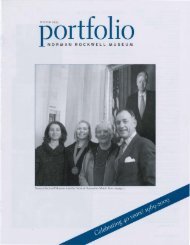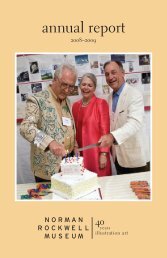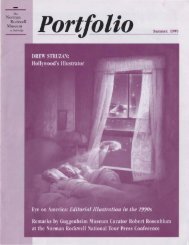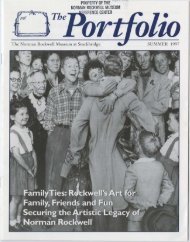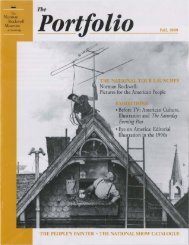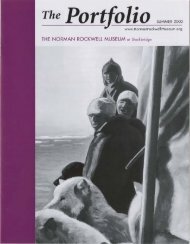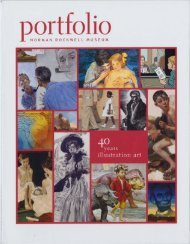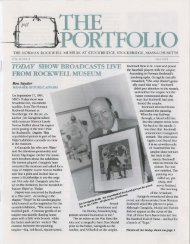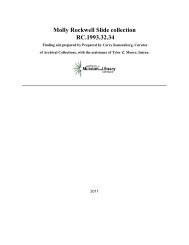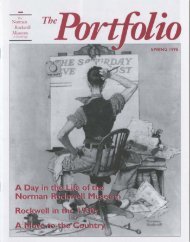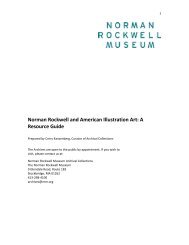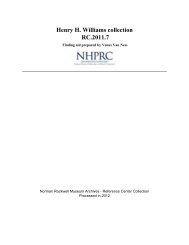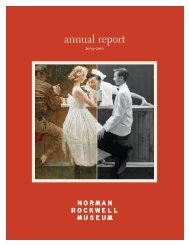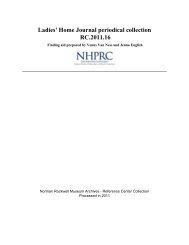Winter 1989 - Norman Rockwell Museum
Winter 1989 - Norman Rockwell Museum
Winter 1989 - Norman Rockwell Museum
Create successful ePaper yourself
Turn your PDF publications into a flip-book with our unique Google optimized e-Paper software.
THE~'~IW'PORTFOLIOTHE NORMAN ROCKWELL MUSEUM AT STOCKBRIDGE, STOCKBRIDGE, MASSACHUSETTSVol. 6, No.3Hallmark LoansHoliday Pieces forSpecial Exhibition<strong>Winter</strong> <strong>1989</strong>Season's Greetings From <strong>Norman</strong><strong>Rockwell</strong>: Holiday Images from HallmarkCards, a special exhibition of 11original <strong>Rockwell</strong> paintings and twopreliminary works commissioned byHallmark Cards for its Christmascard series, brightened the holidaysof museum visitors from November9, <strong>1989</strong>, through January 15, 1990.Scenes of Santa preparing for Christmas,families celebrating the holidays,and Santa's reindeer having a snackwere among the <strong>Rockwell</strong> holidayworks on view in the show. All 13images in the show, most of whichare watercolors, were on loan to themuseum from Hallmark Cards, Inc.Executed between 1946 and 1957,these timeless <strong>Rockwell</strong> Christmasimages are still a popular part ofHallmark's holiday card line. Thewatercolors and studies on view inthis exhibition offered visitors theunique opportunity to see the process<strong>Rockwell</strong> used to create his Christmascards."<strong>Norman</strong> <strong>Rockwell</strong>'s holiday illustrationsfor Hallmark show bothfunny scenes of mere humans playingat being Santa Claus and, in contrast,sentimental fairy tale views of St. Nickhimself," noted Maureen Hart Hennessey,curator at the museum. "Themuseum greatly appreciates the generosityof Hallmark Cards, Inc., inlending these wonderful pictures tous."Hallmark Cards, Inc., which beganselling greeting cards in 1912, is nowthe largest greeting card manufacturerin the worlq.Deciding the Future of The Old Comer HouseAn Interview with <strong>Museum</strong> President Lila BerleThe <strong>Norman</strong> <strong>Rockwell</strong> <strong>Museum</strong>, the repository of one of America's greatestartistic legacies, is a cultural organization with a nationwide reputation.At the same time, the museum is a member of a small rural communityand a citizen of the town of Stockbridge, Massachusetts (year-roundpopulation, 2,500). Although these are two seemingly different personae,the museum has always been able to balance its role as museum with thatof good neighbor by remaining sensitive to the needs of the local community.This hard-won equilibrium faces perhaps its greatest challengeas the museum prepares to move into its new building. Financial considerationsnecessitate that the museum sell The Old Corner House, the currentlocation of the museum, and another of its assets, a building which is nowleased by the United States Postal Service. The sale of two prominenttown buildings, one of which has significant historic value, has naturallyraised many questions in the minds of the caring citizens of Stockbridge,and in Berkshire County as a whole. Stockbridge is a picture-perfect NewEngland town, and its residents take great pride in its history and architecture.The interview which follows attempts to answer some of thesewhich have come up and to outline the process which the museum hasdeveloped to expedite the sales of the two properties in a fair and sensitivemanner. Continlted on page 2
Continued from page 1Why is the museum selling The Old Corner House and the postoffice?The answer to this question is twofold. The museum's primarymission is to protect its collections, not to be in the real estatebusiness. The buildings represent museum assets of approximately$1 million, and it is the board of trustees' fiduciary responsibilityto incorporate these assets into the new museum. The remainderof the funds needed to build the $7.2 million facility will comefrom a $3.5 million bond issued through the Massachusetts IndustrialFinance Agency and a capital drive.Why is the museum selling the buildings now, when the newmuseum will not be completed until 1992?The museum is offering the buildings now because the post office'slease expires in 1991, and the new owner will have the advantagtin negotiating the lease with the United States Postal Service. It isalso necessary that the museum know for certain how much thebuildings will yield. Although we have estimates of the worth ofthe properties, the actual value is important to ascertain for planningand fundraising purposes. No matter when The Old CornerHouse is sold, the museum will continue to occupy it until our newhome is completed. All those bidding on the property are apprisedthat any sale of the buildings is contingent upon this arrangement.How did the museum come to own the post office?When the post office building was offered for sale in 1978, themuseum decided to purchase it. The building is located directlybehind The Old Corner House, and it was felt that the museummight want to expand there (this turned out to be impractical) or,at the least, would be able to control who its closest neighbor wouldbe.Why are you using an outside real estate agent?The museum hired the firm of Julien]. Studley Inc. of New Yorkin order to ensure that the sale of the structures will be fair to all.The firm specializes in unique properties such as ours and hasoften worked with nonprofit organizations. In its contract withthe firm, the museum's board specifically required that local realtorsbe permitted to co-broker the sale.Is it necessary to have "for sale" signs?The museum felt that it was important to let everyone in thetown of Stockbridge know at the same time that the two buildingsare for sale. Signs were the best means of doing this. We have alsobeen advised by our real estate agent that "for sale" signs are aneffective advertising tool. We have a responsibility to our membersand donors to do everything possible to attract interest in theproperties and, ultimately, the best-qualified buyers.Has the museum placed preservation restrictions on The OldCorner House?No. The museum has been advised that such restrictions wouldencumber the bidding process. It is important to remember thatthe museum has the right to reject any or all bids. During the negotiationprocess, the museum will secure historic preservationagreements that will be binding in any contract which results.Why doesn't the museum donate the buildings to the town, asthe Stockbridge selectmen suggested?Although the museum is sensitive to the needs of the town, itsimply cannot afford to give the buildings away. This would be unfairto individuals and corporations who have already donatedmoney to the museum. Donors would (rightly) criticize the museumfor giving away one of its most important assets.What is the museum going to do once The Old Corner House issold if the new building is not yet completed?The museum will remain at The Old Corner House until the newbuilding is completed. Any sale of the property is contingent uponthis arrangement.W ill the museum close for a period of time prior to moving intothe new buildidng?Yes, the museum will close for a short period of time prior to themove in order to safely move the collections and install new exhibits.The exact length of time required has yet to be determined.What effect will these sales have on the town taxes?As a not-for-profit organization, the museum is not required topay real estate tax. However, the museum has always made anannual contribution, the amount of which is equivalent to the assessedtax, to the town in lieu of taxes. We depend on town servicessuch as police and fire protection for the safety of our visitors andcollection, and this is the museum's way of saying thanks. Thebuildings would go back on the tax roles if a business or privateowner were to acquire them.Deely Named Director of DevelopmentPhilip Deely of Tyringham, Massachusetts, has been appointeddirector of development at the museum. Deely replaces Henry H.Williams,Jr., who has assumed, on a part-time basis, his formerposition of assistant director for finance and administration at themuseum.As chief fundraising officer, Deely will be responsible for overseeinga $2.3 million capital campaign to raise funds for themuseum's new gallery building. The campaign is one part of amulti-faceted financing package designed to provide the fundsnecessary to build the new gallery.Deely, who has combined a career in educational administrationwith fundraising and marketing skills, comes to the museumfrom the Emma Willard School in Troy, New York, where he hadbeen principal since 1987 . He has also served as associate headand acting head academic dean at The Ethel Walker School inSimsbury, Connecticut; chairman of the History Department atthe Foxcroft St.:hool in Middleburg, Virginia; and as an instructorat Simon's Rock of Bard College in Great Barrington, Massachusetts."As a native of Stockbridge and the Berkshires, who literallygrew up in <strong>Norman</strong> <strong>Rockwell</strong>'s shadow, I am personally committedto this project," said Deely. "I look forward to helpingmake this new museum building a reality."Deely earned a master of arts degree in history from the U niversityof Chicago in 1972 and a bachelor of arts degree in historyfrom Hobart College in 1969. He also did graduate work at ColumbiaUniversity.2
CURATOR'SCORNERby Maureen Hart Hennessey/Of the more than 800 images <strong>Norman</strong><strong>Rockwell</strong> created for advertising andcommercial uses, the Christmas cardillustrations produced for HallmarkCards, Inc., rank among the most popularand well known. Between 1946 and1957, <strong>Rockwell</strong> painted 33 watercolorsfor Hallmark to be used as holiday greetingcards. Eleven of the final paintings,on loan to the museum from Hallmark,were featured in the exhibit, Season'sGreetings from <strong>Norman</strong> <strong>Rockwell</strong>:Holiday Images from Hallmark Cards,which was on view at the museumthrough January 15, 1990.The process of creating the" right"image for a Christmas card was not aneasy one. "Christmas cards required aspecial kind of picture," <strong>Rockwell</strong> wrote."The Christmas card is the only kindof illustration which is sold only for itself.. .. So it's either right or a flop."While certain images may evoke theholiday spirit, they may not necessarilysell as a Christmas card. Christmas cardsare personal messages: the successfulcard not only illustrates symbols of theseason, but also is one with which anumber of people can identify. Criticalcomments on many of the Christmascard illustrations were sent by Hallmarkto <strong>Rockwell</strong>. These critiques, preservedin the <strong>Norman</strong> <strong>Rockwell</strong> Archive,shed some light on what was considereda successful design and what might"flop."An example of the kind of holidayimage which did not translate wellinto a best-selling Christmas card isLefr, Santa's Visitors by <strong>Norman</strong> <strong>Rockwell</strong> appeared as a Hallmark Chrisrmas card in 1951. Reproducedby permission of Hallmark Cards, Inc.Righr, Santa and His Helpers by <strong>Norman</strong> <strong>Rockwell</strong> was commissioned by Hallmark Cards, Inc.and reproduced as a Chrisrmas card in 1948. Reproduced by permission of Hallmark Cards, Inc.the Dickensian scene. Although <strong>Rockwell</strong>'sSaturday Evening Post Christmascovers which featured Tiny Tim andother nineteenth-century merrymakerswere very popular, the American cardbuyer rejected this type of illustrationfor his or her own holiday greeting.Comments from Hallmark indicate thatsome cards, such as one featuring BobCratchit, "did not sell well because thesubject has an English feeling ratherthan American." Illustrations featuringcouples involved in holiday activitiescould also be problematic. One cardwith a couple dancing under mistletoedid not sell well because, "the mistletoegives the impression that this is aromantic couple rather than a marriedcouple, and cards are sent by marriedcouples." Apparently, a couple couldnot be both married and romantic!Another card was not terribly popularbecause the woman "looks like she isolder than the husband and this is apoint women are a little touchy about."The illustrator had to take care evenwhen using the most beloved symbolof holiday cheer, Santa Claus. The cardSanta's Visitors did not sell nearly aswell as the Number One Santa card "be-cause the Santa is accompanied by onelittle boy and one little girl and so manypeople in selecting it felt it was notappropriate unless they, toO, had a boyand a girl."St. Nick is featured on the <strong>Rockwell</strong>Christmas card which was the best seller,Santa and His Helpers. The saintly oldman, dozing in his chair as eight tinyelves finish the task of toymaking, is a"good hearty useable Santa Claus andis generally liked for a greeting card byeveryone."In the creation of any illustration,<strong>Norman</strong> <strong>Rockwell</strong> was required toplease the sponsor of the commissionedwork, such as the magazine publisheror an advertiser, and the public in boththe choice of subject and in its execution.While <strong>Rockwell</strong> usually was most successfulin these endeavors, the commentsfrom seasoned staff at HallmarkCards indicate just how difficult it was(and is) to create something as deceptivelysimple as a successful Christmascard. That his advertising and commercialillustrations were so very successfuldemonstrates <strong>Rockwell</strong>'s geniusfor choosing subjects and paintingthose subjects.ErratumPortfolio readers may have been mystified by a recentJoin-A-Friend some misspellings slip by. Apologies to those who were confusedletter from the Membership Office. Distribution errors led to the and thanks to those who called the error to our attention.letter being sent to non-members, and poor proofreading let3
Preserving <strong>Norman</strong> <strong>Rockwell</strong>'s LegacyThrough £onservationby Maureen Hart Hennessey, curatorTaking proper care of art collections is the most important step intheir preservation. In many cases, however, artwork may need morethan simply proper care. A catastrophic occurrence may havecaused damage; more often, though, deterioration has been causedby neglect, well-meaning but inappropriate care, or even theinherent properties of the materials used in the artwork. In thesecases, a professional conservatOr needs to be consulted.The purpose of a conservation treatment is to conserve as muchas possible original material of the artwork or antique. Unlike arestOrer, whose aim is usually to bring an object to a "like-new"appearance, a conservator will usually seek to preserve the signsof age, wear, and stress which provide much of the object's histOry.For conservation treatment of our collections, the museum reliesupon the Williamstown Regional Art Conservation Laboratory(WRACL).The WilliamstOwn Lab was founded in 1977 to serve all of thenonprofit collections of the Northeast. Located on the grounds ofthe Clark Art Institute in Williamstown, Massachusetts, the lab isstaffed by conservators specializing in paintings, works on paper,furniture, and three-dimensional objects. The museum has been amember of the WRACL consortium since the consortium'sfounding.Most museums begin a conservation program with a collectioncondition survey conducted by lab staff. This survey. assesses generalenvironmental conditions as well as the need for treatment forindividual objects. Depending on the severity of condition, eachobject is assigned a priority code, ranging from "Urgent Treatment"to "No Treatment." As conservation funds become available,objects are treated based on their priority. The museum's collectionwas surveyed in 1978, and the survey was updated in 1987. Therecently-awarded conservation grant from the MassachusettsCouncil on the Arts and Humanities will allow the museum tocomplete treatment on all subjects identified as in need of urgenttreatment.The treatment of all individual objects begins with a detailedexamination. ConservatOrs use a variety of tOols to assist in theirstudy of a piece, including x-rays, ultra-violet and infra-red lights,and microscopes. A treatment proposal is then developed anddiscussed with museum staff. Once a specific treatment is approved,the actual conservation work begins. Complete records of thetreatment, including photographs, are kept. Treatments mayrange from a simple surface cleaning, at one extreme, to a completerelining of a painting's canvas support with another fabric, at theother extreme. The conservator will also make recommendationsconcerning matters such as the need for a new frame to protectthe painting or an object's ability to withstand the stresses oftraveling.The conservation treatment of <strong>Norman</strong> <strong>Rockwell</strong>'s Triple Sel/Portrait is a good example. The painting was in need of urgenttreatment and was taken to the lab in February 1987. There wereareas of flaking and cracked paint to be consolidated and re-adheredto the canvas; a depression in the canvas in one corner to be flattened;small areas of paint loss to be inpainted; and overall surfacegrime to be removed. The treatment proposal outlined the stepsto be taken to repair and clean the painting, following which a4A photograph of <strong>Rockwell</strong>"sTriple Self-Portrait takenunder ultra-violet light. Thisprocess enabled conservatorsto see areas of the paintingwhich were retouched sometimeafter <strong>Rockwell</strong> completedthe original. The fluorescent(bright white) areas indicatethe retouched areas.TAKING A LOOKThis photograph taken inraking light shows indentationsin the canvas in the upperright corner and along stretcherbars.highly-soluble varnish to protect the painting would be applied.After the painting had been repaired and cleaned over a period of11 months, museum staff met with WRACL conservators todiscuss the next step in treatment. <strong>Rockwell</strong> did not varnish TripleSelf-Portrait after it was completed; for the conservator to varnishthe painting, would be an addition to the artist's work. Furthermore,any conservation treatment must be reversible; that is, itmust be able to be completely removed without damage to theoriginal material of the object. Much of the detail of Triple Sel/Portrait is in pencil, which would be obliterated by the removal ofany added varnish layer. Without varnish, however, the paintingitself is left unprotected. WRACL staff recommended that thepainting be reframed with glass to protect the painting. This wasdone with Denglas, a chemically treated glass with a non-glaresurface. Triple Self-Portrait, currently exhibited at the museum, isnow protected and needs no further treatment at this time.Conservation treatment is an important and sometimes riskystep in the long-term preservation of an artwork or antique. Therefore,activities such as cleaning a painting or work on paper,mending tears in a canvas, or replacing missing parts on a piece offurniture should be left to the trained professionals. The museumis fortunate to have the Williamstown Regional Art ConservationLaboratory here in Ber~shire County, working with us to preserve<strong>Norman</strong> <strong>Rockwell</strong>'s legacy.
AT CONSERVATIONA conservator at work at the Williamstown Regional Art Conservation Laboratory.Conservation Tipsby Linda Russell, assistant curatorArt museums, in addition to being repositories of fine art whichenable the public to view art and participate in the aesthetic experience,play the important role of allowing artwork to live in a stable,secure environment in order to survive and be preserved. Paintingsand drawings can be seen as alive in the sense that they can undergochemical, physical, and biological changes. Changes can occurin paint, the support material, and the matting and framing, aswell as between each of these. Thus, care of objects is crucial inpreserving an art collection.The major causes of damage are a result of changes in relativehumidity levels, temperature, and the effects of light. For example:• Fluctuation of temperature and humidity can cause movementof the layers of paint of an oil painting, which may result incracks and flaking paint.• Changes in humidity levels can cause expansion and contractionof the support material (canvas, paper, wood).• Humid conditions may support the growth of mold and funguson painting surfaces.• Dampness can affect the varnish layer of an oil painting bycausing it to lose its elasticity; the varnish cracks and no longeracts as a protective layer to paint. The yellowing of varnish is anindication that it is losing its elasticity.• Too little humidity can cause embrittlement of paint or paperobjects.• Light can cause photochemical changes in paper objects by, forinstance, breaking down the cellulose in paper.Maintaining a stable environment is the most important factorin the care of artwork. If you have art objects that you want topreserve, there are basic procedures that you can follow to add tothe life of your object.Light: Any paper object should be kept away from direct sunlightand fluorescent light since these two kinds of light emit ultravioletradiation. Incandescent light is less harmful; however, the lesslight used, the better. Using no more than the amount of lightneeded for reading, a 150-watt bulb at a distance of four to fivefeet, is desirable. Oil paintings can tolerate more light, but if thelight is strong enough to generate extra heat, it could be damagingbecause of the effects of heat. Light will fade objects, and that fadingis irreversible. If you think of your walls at home as exhibit spacethat is changed periodically, paper objects will suffer less. Evenafter an object is placed in dark storage, the effects of damaginglight continue for a short period of time. House paint can be UV(ultraviolet) absorbing or reflecting. Before purchasing paint,check with your paint dealer to find out its properties.Temperature: Drying from overly heated air can cause thevarnish or paint layer to become embrittled and crack, but moreimportantly, the fluctuation from dry to damp causes damage inpaintings and paper objects. If the temperature changes too quickly,the result can be condensation within paper itself. It is better notto hang pictures on outside walls where it is more likely to bedamp and where changes in temperature may be more drastic.Likewise, hanging pictures over radiatOrs, air ducts or fireplacesshould be avoided. Direct sunlight is also a source of intense heat.The latest recommended ideal temperature for paper, in a settingthat must also be comfortable for people, is 65 degrees F.Humidity: Paper is hygroscopic, meaning that it will easilyabsorb moisture. In the summer, outside air has a relative humidityof approximately 70% to90%. In the winter, it is about 10%. Thelatest recommended ideal relative humidity is 45 % , plus or minus5% . When relative humidity is over 70%, it is ideal for moldgrowth; if it is under 30%, embrittlement can occur. "As materialsabsorb moisture, they swell and contract. On a microscopic level,they never return to exactly the same shape, so new surfaces arealways being exposed to damage. This stretching and shrinkingalso causes mechanical breakdown" (Monitoring Temperatureand Relative Humidity/ Creating a Climate for Preservation,Northeast Document Conservation Center).Clearly, paintings or paper objects should never be stOred inattics or basements because of the extremes of temperature andrelative humidity. If you live in a warm climate and come northfor the summer or live in the North and go south in the winter,and your home is closed up without temperature controls to maintaina fairly constant temperature and humidity, objects should beremoved and placed in secure and environmentally stable storagefor the interim.Another factor in the care of paintings and drawings is theirimmediate environment of matting and framing. Cared-for objectsshould not come in direct contact with acidic materials such asnon-acid-free mat board or backing board. The chemicals from anacidic mat can migrate to the picture, causing staining and weakeningof the support material. If you are unsure what materialyour mat and backing board are made of, you can consult a framer.If the inner layer of the board is a different color from the exposedsurface, it either is made from non-acid-free material or has beenbuffered with an alkaline chemical to neutralize the acidity. Bufferingwill break down over time; therefore, it is better to go to theexpense of using only "museum board." Also, never frame apicture directly against glass since moisture condensation canoccur, causing mold growth and, in some cases, the picture can stickto the glass. Self-adhesive tapes should also be avoided because oftheir high acid content and because they attract certain insectsthat like to eat adhesive glues.Inquiries regarding basic conservation information can be directedto a museum in your area. If you wish to find a conservatOr orconservation laboratory, a list of practicing conservators can beobtained by writing to: American Institute for Conservation ofHistOric and Artistic Works (AlC), 3545 Williamsburg Lane N . W.,Washington, DC 20008.5
Maud Coyle, at left. Right, Maud Coyle and Robyn Kampe, school program coordinator, are developing exciting new programs at the museum for srudenrs, families,and individuals.Maud £oyle Hired as Assistant Directorfor Education and ProgramMaud Coyle has joined the museum staff as assistant directOrfor education and program. Coyle replaces Margaret Batty, whoheld a similar position at the museum for 17 years and retired inMarch of this year at the age of 80.Coyle will be responsible for developing and implementingeducational programming at the museum. She will oversee thedaily operation of The Old Corner House facility, and will superviseand train the guide staff. Currently, the museum runs anumber of programs for area school children and their teachers,as well as sponsoring lectures and other events focusing on tOpicsrelating to <strong>Rockwell</strong> and the field of illustration. Coyle also bringssubstantial planning experience in short- and long-range planningand will playa vital role in the exhibition and interpretation planningfor the museum's new building.Coyle comes to the museum from the <strong>Museum</strong> of the City ofNew York, where she had been the head of education since 1987.Coyle began working at Old Sturbridge Village in 1982 and heldthe position of assistant director of its <strong>Museum</strong> Education Departmentfrom 1985 to 1987. She also served as a teacher and administratorin New York's public and private schools. Coyle will continueto serve as an adjunct staff member at the Bank Street College ofEducation in New York.Coyle earned a master of science degree in museum leadershipfrom the Bank Street College of Education, did graduate work inanthropology (archaeology) at New York University, and receiveda bachelor of arts degree in education from Queens College, CityUniversity of New York."Maud Coyle is an important addition to our staff, and we arevery excited to have her with us," noted Laurie NortOn Moffatt,director of the museum. "Under her leadership, we will expandthe education programs the museum offers for a wide variety ofconstituencies-everyone from special groups such as schoolchildren,families, the elderly, and the handicapped to generalvisitors. Her planning experience and background in museumfacility expansion will be an invaluable asset as we develop programmingfor the museum's new home."6From the Director by Laurie Norton MoffattHolidays are a time to give thanks for the many kindnesses andblessings we derive throughout the year. The <strong>Norman</strong> <strong>Rockwell</strong><strong>Museum</strong> has so much to give thanks for this year as we concludeour twentieth year of operation. We are thankful for the 150,000visitOrs who enjoyed the museum's offerings this year- tOurs,exhibits, school programs, lectures, gallery talks, special openings,our bus trip, bicycle tour, art show, and even our fence-paintingparty! This is an increase of 18,000 people over 1988. Our membershipranks have grown-a very special group of people whopledge their commitment and belief in <strong>Norman</strong> <strong>Rockwell</strong> and inthe museum through an annual gift. To all those who have volunteeredtheir time-our volunteers, board members, and goodwillambassadors- my deepest thanks. You are our emissarieswho ensure our future growth and success. A huge thank you, ~oo,to our devoted staff, who make possible our fine programs andcare for our collections. And our greatest tribute is owed to Mr.<strong>Rockwell</strong>, without whose paintings, ideas and compassionatevalues we would not exist.As a practical response to the overwhelming successes we haveenjoyed,this year, I am pleased to announce a change in our hoursin the new year. During our busiest season from May 1 throughOctOber 31, we will keep our current public hours, daily from 10:00a.m. to 5:00 p.m. (groups are invited to take advantage of specialreservations as early as 9:00 a.m.).From November 1 through April 30, when school is in session,we have modified our public schedule to better accommodate ouradult and children's audience, due to the small gallery spaces inour 200-year-old home. To recognize our commitment to educationand our younger audience, we will be reserving the hours of 9:00to 11:00 a.m. for our local and regional school groups in the fourstateregion (Massachusetts, New York, Connecticut and Vermont).The galleries will open to the general public at 11 :00 a.m. andclose at 4:00 p.m., when darkness falls early in the Berkshirewinter. Some special pilot education programs will be offered onoccasion in the late afternoon. On weekends, holidays and schoolvacations, we will continue to be open from 10:00 a.m. to 5 :00 p.m.We think this will help us serve you better as we await our largerquarters in the new building. For some exciting news and updateon the new building, be ~ure to read "New Gallery News."Thank you to all who continue to make the museum grow andprosper. Best wishes for a happy and joyous new year.Archival Acquisitionsby Linda Russell, assistant curatorElizabeth H . Kaufman of South ThomastOn, Maine, has donated12 postcards picturing Willie The Thrush, one of 25 illustrationsfrom the children's book Willie Was Different. The book was acollaboration between Molly and <strong>Norman</strong> <strong>Rockwell</strong>; Molly and<strong>Norman</strong> wrote the text, and <strong>Norman</strong> created the illustrations.The postcards were used as promotional material to advertise thebook.Timothy Moran of Nahant, Massachusetts, donated two rotOgravuresections from the February 4,1962, Boston Sunday Herald.The cover illustration of the section is a reuse of the painting offormer State Trooper Richard Clemens. <strong>Rockwell</strong> originally paintedthe portrait of Clemens as an illustration for a 1961 MassachusettsState Police Christm~s card.
Henry H. W illiams,J r., of Stockbridge, Massachusetts, donated acopy of the 1964 Stockbridge Annual Report. The cover illustrationfor the booklet is a reuse of a drawing <strong>Rockwell</strong> did for MassachusettsMutual Life Insurance Company. Mr. Williams alsodonated a poster of "Artists in the Southern Berkshires."Steven and Lorraine D octrow of Pittsfield, Massachusetts, havedonated a "philatelic tribute" to <strong>Norman</strong> <strong>Rockwell</strong> consisting of alithograph of the Triple Self Portrait image and three <strong>Rockwell</strong>postage stamps.Pearl Rosenbaum of Stamford, Connecticut, has given the museuma collection of magazine covers, tear sheets and other ephemera,primarily from the Saturday Evening Post, illustrated by <strong>Norman</strong><strong>Rockwell</strong> and several other illustrators.Jeanette Pieper of Harwich, Massachusetts, has donated her personalscrapbook of <strong>Norman</strong> <strong>Rockwell</strong> memorabilia which includesclippings and magazine articles about <strong>Rockwell</strong>.The museum is very grateful to these contributors for helping tobuild the archives of The <strong>Norman</strong> <strong>Rockwell</strong> <strong>Museum</strong> at Stockbridge.<strong>Museum</strong> Hires On-Site ConstrudionProjed CoordinatorArchitect and construction specialist David 1. Slingerland ofAnnandale, Virginia, has been appointed construction projectcoordinator. Slingerland comes to us from the Smithsonian Institutionin Washington, DC, where he had been deputy director in theOffice of Design and Construction since 1981.Slingerland will provide on-site project management and serveas a liaison between the museum, architects, engineers, and contractorsduring construction of the museum's $7.2 million building,which will be built at the Linwood site in Stockbridge. As constructionproject coordinator, Slingerland will work closely with museumofficials and architect Robert A. M. Stern over the next two tothree years. Groundbreaking is expected to take place in June of1990; a groundbreaking date will be announced following thecompletion of the next building design phase in early 1990. Thenew building is expected to open by May of 1992 .Slingerland's responsibilities include review and analysis ofcontracts, bids, design documents, cost projections and other data;project quality control; scheduling; and inspection and testingservices. During the initial months of operation of the new facility,he will coordinate maintenance and operational procedures,exhibit installation, and furniture and equipment installation."T he increased volume of museum construction during the1980s resulted in the emergence of an experienced group of professionalswho specialize in museum construction and its uniqueneeds. The <strong>Norman</strong> <strong>Rockwell</strong> <strong>Museum</strong> has reached the phase ofits design process where it is appropriate to bring in a staff specialistto direct the project through completion," said Laurie NortonMoffatt, director of the museum. "Me. Slingerland has a broadrange of expertise in design development, construction detailing,contract document preparation, specification writing, estimating,construction management, and contract administration.""Me. Slingerland's experience and talents will be an invaluableasset to the museum during the construction of our new building,"noted Lila Berle, president of the board of trustees.Slingerland earned a bachelor of architecture degree from SyracuseUniversity in 1960 and taught and did graduate work at thatsame institution from 1964 to 1966.Theodore EvansH arvey "Cher" KrenczmanTheodore Evans and Harvey t. KrentzmanAppointed to Board of TrusteesTheodore Evans, an Episcopal minister and rector of St. Paul'sEpiscopal Church in Stockbridge, and Harvey C. Krentzman,president of a financial and management consulting company inChestnut Hill, Massachusetts, have been appointed to the museum'sboard of trustees. The board now totals 27 members.Evans, who served on the board from 1977 to 1983, at whichtime his term expired, has been the rector at St. Paul's since 1974.Before coming to Stockbridge, Evans was associate Episcopalchapl~in at Harvard and Radcliffe Colleges and staff assistant atChrist Church in Cambridge. Evans was also the priest-in-chargeof the Mekong District from 1963 to 1967. As such, he was responsiblefor congregations of English-speaking Anglicans in areas ofCambodia and V iernam. He has also done theological work inHong Kong. Evans earned a bachelor of arts degree from HarvardCollege in 1957 and a master of divinity degree from VirginiaTheological Seminary in 1961.Harvey "Chet" Krentzman, president of Advanced ManagementAssociates, Inc. and an eminent small business managementconsultant, has also joined the board. Over the years, Krentzmanhas been very involved with Boston's business community as anentrepreneur, educator, author, and management consultant. Heis a member of the Boston Symphony Orchestra's board of trusteesand is the founding chairman of the symphony's Business andProfessional Leadership Committee. He also serves as a trustee ofBeth Israel Hospital and Northeastern University. Krentzmanearned a bachelor of science degree in mechanical engineeringfrom Northeastern University in 1949, a master of science degreefrom Harvard University in 1950, and a master of business administrationdegree from Harvard's Graduate School of Arts andSciences in 1952.<strong>Museum</strong> Awarded Conservation GrantThe Massachusetts Council on the Arts and Humanities hasawarded the museum a $2,570 conservation grant to be spreadover two years (1990 and 1991). The museum will use the MassCouncil funds to conserve three paintings which are among themost important and popular works in its permanent collections.A Family Tree (1959), The Marriage License (1955 ), and TheGolden Rule (1961) were all painted by <strong>Rockwell</strong> during the peakof his career and while he lived in Stockbridge. All three paintingsare in urgent need of conservation. The conservation work will bedone by the Williamstown Regional Art Conservation Laboratory.7
y Laurie Norton MoffattAt the December 4, <strong>1989</strong>, meeting of the board of trustees, thelocation of the new gallery building on the Linwood property wasvoted, allowing detailed design work on the building to commence.Analysis and examination of the lovely garden site revealedthat the optimum location for the building is along the southcolumn of trees of the tree-enclosed formal garden in whichpeacocks used to roam. Factors ranging from water table, cost,tree preservation, land contours, and truck access, to visitor accessibility,parking and preservation of aesthetic views influenced thefinal decision. Now that this location has been voted by the board,detailed design work can commence as we work toward groundbreakingin 1990.With the arrival of Dave Slingerland as construction projectmanager, the museum brings on staff the combined talents of anarchitect and museum professional experienced in the uniquechallenges of new museum design. He completes the professionalstaff team responsible for program exhibition and buildingdesignplanning which will assist in the smooth transition fromThe Old Corner House to the new building at Linwood. Mr.Slingerland and Board Construction Committee Chairman CharlesSchulze have been making regular trips to New York City to meetwith architect Robert A.M. Stern and the project team. A constructionschedule for ground breaking and completion will appear inthe next issue of the Port/olio.Membership Insights • • •by David Staples, director of membershipAs the year ends, a sincere thank you for continuing to support themuseum. Renewals and members rejoining the museum have increasedby some 400%. It is not idle banter when we tell you thatyour membership enables us to implement current programs andcreate new ones. Our museum is a rarity in the art world, as it earnsalmost all its operating revenues.Your membership and the funds it represents are helping usbuild the new museum. Membership programs are an integralpart of museum life. Capital campaigns are for specific periods ofdevelopment, while membership revenues are forever an importantelement in fostering a healthy museum environment.With the multitude of solicitations and choices of membershipfor worthy causes in our society, your choice in supporting The<strong>Norman</strong> <strong>Rockwell</strong> <strong>Museum</strong> is deeply appreciated.~ The Nonnan <strong>Rockwell</strong> <strong>Museum</strong> at Stockbridge~Stock bridge, Massachusetts 01262Non ProfitOrganizationU.S. PostagePAIDPermit No. 33Stockbridge, MA 01262Board of TrusteesThe <strong>Norman</strong> <strong>Rockwell</strong> <strong>Museum</strong> at StockbridgeLila W . Be rl eD avid L. KI. usmeyerPaul W . IvoryWilliam J. N apo litanoJa ne P. FitzpatrickBrian J . Q ui nnGeorge P. Ada msH arry W . Albright, J r.Joh n T. Batty IIID avid S. BrookeCong o Sil viu O . ConteLinda DayJ u h n M. D eely, J r.Patricia DeelyT heodore H . Eva nsW ill iam GoesselH e nry Bossett H o ltPresidentFirst V ice-Preside ntSecond V ice-PresidentTreasurerClerkLegal CounselH arvey C. K re ntzmanJo rja-A nn P. M arsdenLinn Ca ry Meh taNorma G. OgdenDorothy B. PerkinsCha rles T. SchulzeM ark L. SelkowitzBeurr R. SerVaasRosamo nd E. S he rwoodSteven SpielbergPROPERTY OF THENORMAN ROCKWELL MUSEUMREFERENCE CENTERLau ri e Norton MoHanJanet S ilverman TobinDirecrorEditore 1990 The <strong>Norman</strong> RtKkwe ll M uSt"um ;.If 510ckbridgeFunded in pa n. by the Massachusetts Slale Council on the Arts and H limaniliL'~.
A ,Program for Everyone:<strong>Museum</strong> to Offer Special <strong>Winter</strong> ActivitiesThe museum's Education Department has designed a number ofinteresting and exciting programs to prevent winter doldrums.Sundays at 3This gallery talk series provides a detailed look at <strong>Rockwell</strong>'s boundlessvision of the American experience. Knowledgeable guidesinvite you to step back into bygone days, as revealed in favorite<strong>Rockwell</strong> images. The 45 -minute talks begin at 3 p.m. Each talkinvestigates a different theme and offers diverse perspectives on<strong>Rockwell</strong> as artist and social historian. Gallery talks are free. Thesetalks are held on the following Sundays at 3 p.m.: February 4, February18, March 4, March 18, April 1, and April 15<strong>Winter</strong> Family Fun To-Dos: Ordinary Faces, Places, and ThingsShare a winter Sunday afternoon together in a program that willinvolve your family in a first-hand investigation of <strong>Rockwell</strong>'s art.This exciting new series of 45 -minute gallery explorations is designedaround activities that stimulate observation, curiosity, andcreativity. No advance registration is required, and families maycome to one, two or all three of these programs. Family To-Dosare offered from 3 p.m. to 4:30 p.m . Recommended for familieswith children ages 5-10. Free for museum members; nonmembers(adult and child), $2.00 per person. Ordinary Faces will be held onSunday, February 25; Ordinary Places will be on Sunday, March25, and Ordinary Things will round out the series on Sunday, April29.Vacation Week Family Tours: A Family AlbumYou are invited to stroll down memory lane and experience familiarmoments, places, and times. Family tours will be offered daily at11 a.m. and 2 p.m. from April 16 through April 22 . Kids of all ageswill be asked to .. remember when" grandmothers had pugs, carshad rumble seats, and games had no moving parts. These participatorytours are 45 minutes long and use <strong>Rockwell</strong>'s cherishedillustrations to trace America's family album. Free for museummembers; nonmembers (adult and child) are $2.00 per person.All programs are held at The Old Corner House, Main Street, Stockbridge
Sunday, February 18Sundays at 3Old Corner House, 3 p.m., freeExhibitionsJanuary 27, 1990-November 6,1990<strong>Norman</strong> <strong>Rockwell</strong>: "Kid With the Camera Eye"An exhibition of <strong>Rockwell</strong>'s working photographs which focuson his special relationship with the camera and the theatrical natureof his artistic process.Old Corner HouseJanuary 27, 1990 -January 1991Looking Back: <strong>Rockwell</strong> Paints the Twentieth CenturyA sampling of <strong>Rockwell</strong> works which depict histOrical turningpoints during this century.Old Corner HouseSunday, February 25Ordinary FacesOld Corner House, 3 p.m.Free for museum members; nonmembers (adult and child), $2.00per personThursday, March 1LectureJames MacGregor Burns, historian and Pulitzer-Prize-winningauthor, will speak.<strong>Museum</strong> members, free; public, $3.00Tickets sold at the doorRed Lion Inn, 7:30 p.m.Sunday, March 4Sundays at 3Old Corner House, 3 p.m., free.Sunday, March 18Sundays at 3Old Corner House, 3 p.m., free.Sunday, March 25Ordinary PlacesOld Corner House, 3 p.m.Free for museum members, nonmembers (adultandchild),$2.00per personSunday, April 1Sundays at 3Old Corner House, 3 p.m., freeThe Final ImpoJJibitity: Man's Tracks on the Moon, an oil study done by <strong>Rockwell</strong>in 1969 ( the final illustration appeared in Look magazine on December 30, 1969),will be on view in Looking Back: <strong>Rockwell</strong> Paints the Twentieth Century at themuseum from] anu:lry 27, 1990, throughJanuary of 1991 . © Copyright 1969, Estateof N orman <strong>Rockwell</strong>.March 31-Apri16Berkshire County High School Art Show(cosponsored with Pittsfield Art League)Linwood House, 10 a.m.-5 p.m.Special EventsSunday, February 4Sundays at 3Old Corner House, 3 p.m., free.Thursday, February 15Members' Opening ReceptionLooking Back: <strong>Rockwell</strong> Paints the Twentieth CenturyOld Corner House, 5:30-7 p.m.Friday, February 16Gallery TalkLoo'king Back: <strong>Rockwell</strong> Paints the Twentieth CenturyOld Corner House, 4 p.m., freeSunday, April 15Sundays at 3Old Corner House, 3 p.m., freeMonday, April 23Members' Bus Trip to New York City Illustration GalleriesBus will leave StOckbridge at 6:45 a.m. and will return at 8:15 p.m.Member fee: $30.00; nonmember fee: $45 .00. Luncheon included.Call (413) 298-4239 by March 20 for reservations and details.Sunday, April 29Ordinary ThingsOld Corner House, 3 p.m.Free for museum members; nonmembers (adult and child), $2.00per personThe museum will be closed January 16 through January 26.The Old Corner House is located on Main Street in Stockbridge.Linwood House is located on Route 183 in Stockbridge.The Red Lion Inn is located on Main Street in StOckbridge.Call (413) 298 -42 39 for further informa tion on these even ts andexhibitions.



